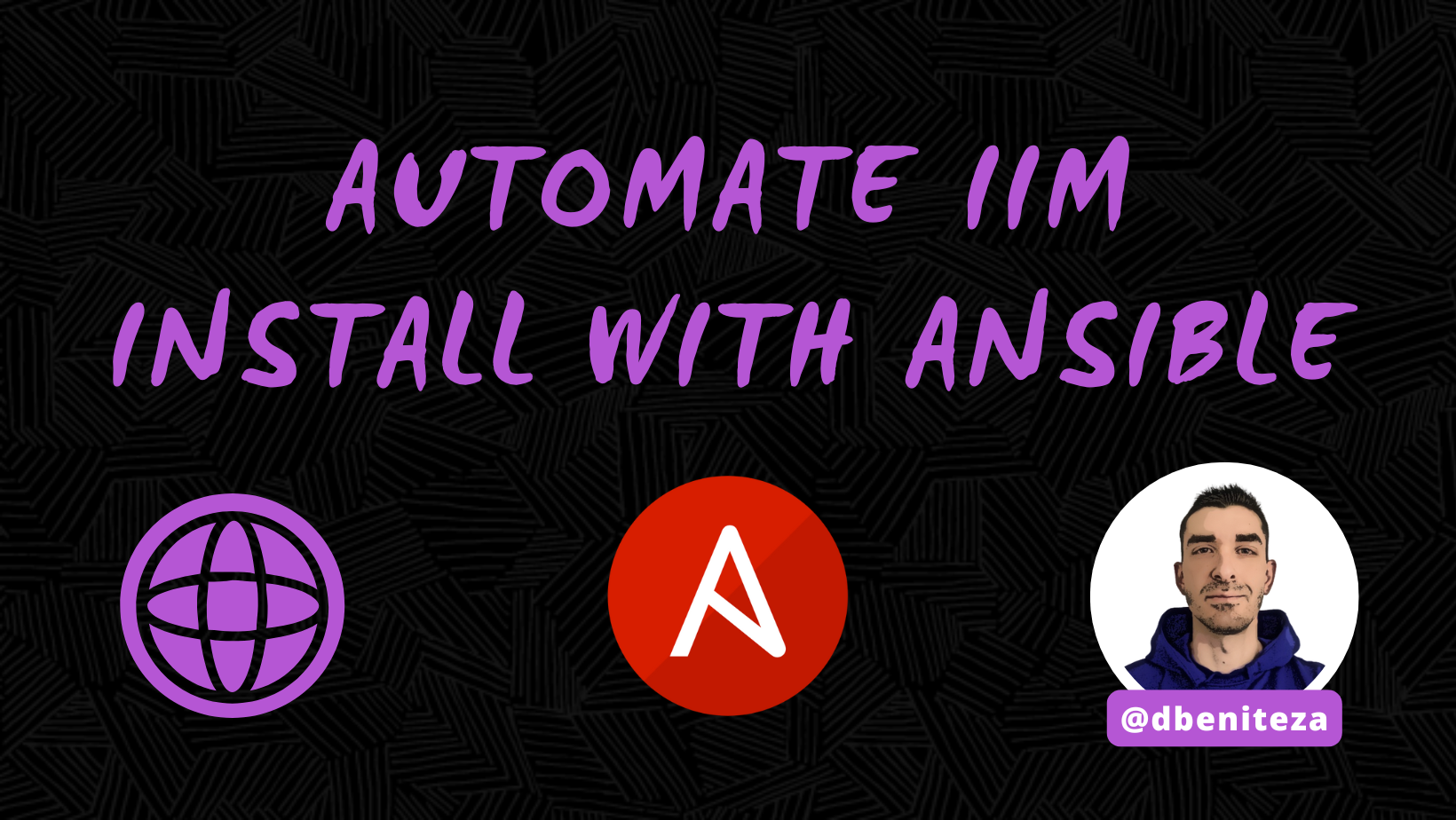Automating IBM Installation Manager Installation with Ansible
 Daniel Benitez
Daniel Benitez
Automating IBM Installation Manager Installation with Ansible
If you're looking to automate the installation of IBM Installation Manager (IIM) for WebSphere Application Server using Ansible, this guide is for you! We'll walk through creating an Ansible role to handle the installation process, making it simple and efficient.
Step 1: Create the Ansible Role Structure
First, let's set up the directory structure for our Ansible role. You can create a new role using the ansible-galaxy command:
ansible-galaxy init my_ansible_role
This command will create the following directory structure:
my_ansible_role/
├── defaults/
│ └── main.yml
├── files/
├── handlers/
│ └── main.yml
├── meta/
│ └── main.yml
├── tasks/
│ └── main.yml
├── templates/
├── tests/
│ └── inventory
│ └── test.yml
├── vars/
│ └── main.yml
For this particular role, we only need the defaults, tasks, and templates directories. We'll define our variables in defaults/main.yml, our tasks in tasks/main.yml, and our response file template in templates/iim_responsefile.xml.
Step 2: Define Variables in defaults/main.yml
In the defaults/main.yml file, we'll define the necessary variables for the installation:
# defaults/main.yml
iim_install_path: "/opt/IBM/InstallationManager"
iim_binary_file: "agent.installer.linux.gtk.x86_64_1.9.0.20190715_0328.zip"
iim_version: "1.9.0"
iim_binary_path: "/software/was/iim/{{ iim_binary_file }}"
Step 3: Create Tasks in tasks/main.yml
In the tasks/main.yml file, we'll define the tasks to install IIM using the cmd module. We'll also create a temporary directory for log files, extract the IIM binary, template out the response file, and ensure the temporary directory is removed after the installation:
# tasks/main.yml
- name: Create temporary directory for logs
ansible.builtin.tempfile:
state: directory
register: temp_dir
- name: Extract IIM binary
ansible.builtin.unarchive:
src: "{{ iim_binary_path }}"
dest: "{{ temp_dir.path }}"
remote_src: yes
- name: Template out the response file
ansible.builtin.template:
src: iim_responsefile.xml
dest: "{{ temp_dir.path }}/iim_responsefile.xml"
- name: Install IBM Installation Manager
ansible.builtin.command: >
{{ temp_dir.path }}/userinstc
-acceptLicense
-installationDirectory {{ iim_install_path }}
-dataLocation {{ iim_install_path }}/data
-log {{ temp_dir.path }}/install_log.xml
-input {{ temp_dir.path }}/iim_responsefile.xml
args:
creates: "{{ iim_install_path }}/eclipse"
- name: Remove temporary directory
ansible.builtin.file:
path: "{{ temp_dir.path }}"
state: absent
when: temp_dir.path is defined
always: yes
Step 4: Create the Response File Template in templates/iim_responsefile.xml
In the templates/iim_responsefile.xml file, we'll create a Jinja2 template for the response file:
<!-- templates/iim_responsefile.xml -->
<agentInput>
<server>
<repository>
<repository location="{{ iim_install_path }}"/>
</repository>
</server>
<install>
<offering features='agent_core,agent_jre' id='com.ibm.cic.agent' version='{{ iim_version }}'/>
</install>
</agentInput>
Step 5: Example Execution of the Role
To execute the role, create a playbook install_iim.yml:
# install_iim.yml
- hosts: all
roles:
- role: my_ansible_role
Run the playbook using Ansible:
ansible-playbook install_iim.yml
Example AWX Job Template Output
When you run the playbook in AWX, you might see output similar to this:
PLAY [all] *********************************************************************
TASK [Gathering Facts] *********************************************************
ok: [localhost]
TASK [my_ansible_role : Create temporary directory for logs] *******************
changed: [localhost]
TASK [my_ansible_role : Extract IIM binary] ************************************
changed: [localhost]
TASK [my_ansible_role : Template out the response file] ************************
changed: [localhost]
TASK [my_ansible_role : Install IBM Installation Manager] **********************
changed: [localhost]
TASK [my_ansible_role : Remove temporary directory] ****************************
changed: [localhost]
PLAY RECAP *********************************************************************
localhost : ok=6 changed=5 unreachable=0 failed=0 skipped=0 rescued=0 ignored=0
Conclusion
With this Ansible role, you can automate the installation of IBM Installation Manager for WebSphere Application Server, making the process seamless and efficient. By defining variables, tasks, and templates, you ensure a consistent and repeatable installation process.
Feel free to leave any questions or comments below. 😊
Useful Links
For more detailed information, you can refer to the official IBM documentation:
Install and Manage WebSphere Application Server with IBM Installation Manager
Installation Manager and Packaging Utility download documents
Happy automating! 🚀
Subscribe to my newsletter
Read articles from Daniel Benitez directly inside your inbox. Subscribe to the newsletter, and don't miss out.
Written by

Daniel Benitez
Daniel Benitez
👋 Hi! I’m Dani, a passionate automation, Ansible, DevOps, and Cloud technologies enthusiast. I currently work as a Middleware Solutions Architect at Atradius, leading middleware automation and optimizing IT infrastructure. 💡 My Story: I started my career specializing in Oracle Middleware, working with technologies such as WebLogic, Oracle Database, Oracle iPlanet Web Server, and Oracle JDK. Over time, my focus shifted towards deployment automation, continuous integration, and process optimization in complex enterprise environments. 🚀 Impact & Achievements: ✅ Direct the automation of Oracle Fusion Middleware (FMW) with Ansible, streamlining the installation, configuration, and patching processes for Oracle WebLogic, SOA Suite, and OSB. ✅ Lead IBM WebSphere Application Server (WAS) automation with Ansible and AWX, including installation, configuration, certificates, and deployments, reducing implementation times by 70%. ✅ Integrated Azure DevOps with AWX, eliminating manual deployment tasks and reducing human intervention to a simple approval step. ✅ Mentor and train teams on Ansible automation, fostering continuous improvement and knowledge transfer. 🏀🥎 In my free time, I enjoy playing padel and basketball, always looking for new challenges and improvements, both in sports and technology. I also love building web applications with Oracle APEX, bringing ideas to life through low-code development. 📥 Let’s connect! 📧 Email: dbenitez.vk@gmail.com 🔗 LinkedIn: https://www.linkedin.com/in/danielbenitezaguila 💻 GitHub: https://github.com/dbeniteza